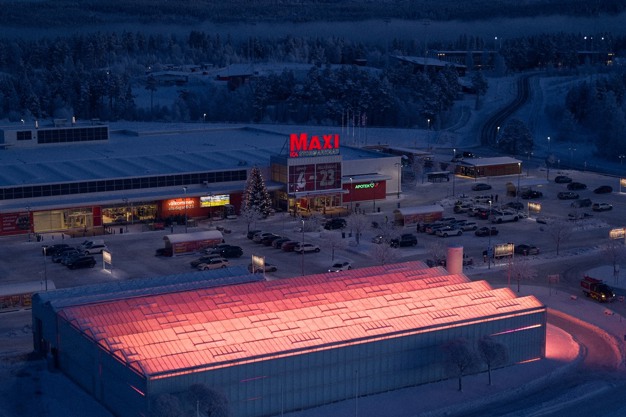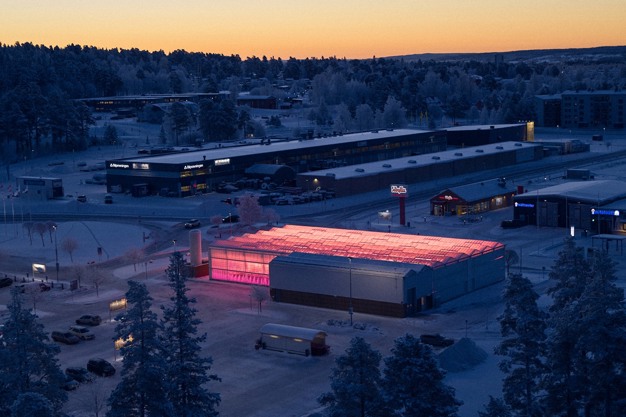For Swedish greenhouse company Agtira, "local produce", or growing "närodlat" in their terms, is much closer to the customer than one would imagine. Erik Jonuks, CEO of Agtira, highlights this innovation: "Our latest 3,000 square meter greenhouse is located in the parking lot of the ICA Maxi hypermarket in Haninge, allowing cucumbers to travel just five minutes from farm to store."

Quality over distance
This facility is part of Agtira's strategy to grow produce on-site at retail locations, eliminating additional transport costs.
Erik asserts that the quality of their fresh produce is incomparable to imported cucumbers, which typically take 8 to 10 weeks to arrive and travel over 3,000 kilometers. The Haninge facility focuses primarily on cucumbers.
All about the retailer
The Swedish retail market is dominated by four major stakeholders, with ICA Maxi being the largest. Jonuks notes that with ICA Maxi, the store manager is the owner too, leading to significant influence over operational decisions. "The owner is very involved in the store's management decisions, enabling us to work closely together. It is very competitive in this regard since he also has access to the central ICA facility which they can source cucumbers from as well. We need to convince and demonstrate the benefits of partnering with us for even fresher, more local produce," Erik explains.
Local production and training
Dumitru, Agtira's production manager, explains that their team runs the ICA Maxi facility independently, utilizing their staff based at the store. Agtira has established an internal training program, the Agtira Academy, to equip its employees. This working model allows for year-round cultivation, differentiating Agtira from many southern competitors who rely on seasonal labor.
Overcoming challenges
Agtira faces several challenges as it scales up production. One major hurdle is convincing retailers to buy directly from producers, which is something different from what they are used to according to Erik. Jonuks points out that while the store in Östersund is self-sufficient in cucumbers and partly in tomatoes and herbs, thanks to Agtira's facility in the store's parking lot, it takes time to build similar commitments with other retailers.
Despite these challenges, Agtira has secured a ten-year exclusive supply contract with Lidl, marking them pioneers in the local market. Erik states, "This agreement has influenced the entire retail industry in Sweden, prompting retailers to rethink their supply strategies. It is more beneficial to have a constant supply throughout the year and not be dependent on seasons and imports."

Leveraging Nordic advantages
Dumitru elaborates on the difficulties of growing cucumbers in the Nordic climate, where cold weather and limited sunlight require the use of artificial heating and lighting. However, Erik sees this challenge as an opportunity: "We benefit from cheap energy, a stable grid, and a reliable water supply, as well as low land costs compared to central Europe."
Agtira utilizes municipal residual heat from urban areas to reduce heating costs in their greenhouses and is exploring collaborations with heavy industries to harness additional heat waste. They have a few projects like this in the pipeline.
A dual approach to distribution
Agtira aims to balance developing their "super" local production model with central distribution points for stores that do not have the capacity for a greenhouse on-site, enhancing Sweden's self-sufficiency in cucumbers. The company's facility in Härnösand for example serves as a central distribution point, optimizing logistics for both Lidl and other partners.
Erik notes that during winter, when prices for produce are higher due to increased imports and limited supply, Agtira often sees better profitability. However, maintaining competitive pricing year-round remains a challenge, requiring continuous optimization of production efficiency from Dumitru and his team.
Innovating with aquaponics
In addition to traditional greenhouse operations, Agtira is investigating the integration of aquaponics, combining greenhouse and fish production. Dumitru explains, "We recycle water between the fish and greenhouse systems, reducing costs associated with artificial fertilizers."
Erik emphasizes the risk involved in this model, as fish production has a longer life cycle and is more vulnerable to setbacks compared to fast-growing crops like cucumbers. "It is easier to amend problems in the shorter cucumber growing cycles when something goes wrong where the longer fish culture gets more costly very quickly."
A new business model: Farming as a Service
Agtira invests, through partnerships, in on-site facilities, thus becoming a tenant in its "own" facility. The store commits by purchasing a predetermined volume over a set period, essentially buying vegetables as a service. Agtira's staff are experts in greenhouse cultivation in this context and can optimize the production not only in terms of quality but also based on the store's actual needs, which vary throughout the year.
With ambitious plans to ensure Sweden achieves self-sufficiency in cucumber supply within the next three to five years, Agtira produces approximately 2,000 - 2,500 tons of cucumbers per year across all sites, which already represents a significant portion of Sweden's cucumber production.
For more information:
Agtira
https://www.agtira.com/
Erik Jonuks
Email: [email protected]
